Resources
Resource 1: Word wall topics
When a collection of words is displayed in a classroom in an organised way, it is often called a ‘word wall’. This display can be used as an interactive resource for reading, writing, vocabulary development, spelling patterns, word/picture association and referencing. Word walls can be categorised into different themes such as colours, names, daily routine words, help words and number names, words with the same starting or ending letters, and word families.
Word walls are a low-cost way for any teacher to help students to develop and reinforce their English vocabularies in any topic, from science to art. There is no limit to the word walls you can develop. The size and shape of your word wall will depend on the size and shape of your classroom. You can use the chalkboard, chart paper, paper and string, or simply the walls inside and outside your classroom.
Look at Figures R1.1–1.3 and think about what is possible in your classroom.
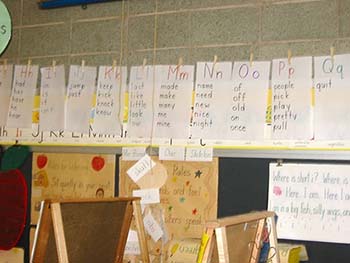
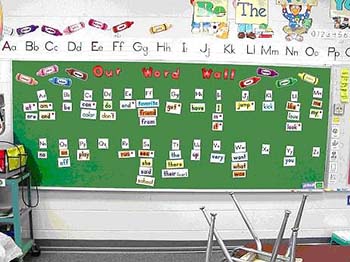
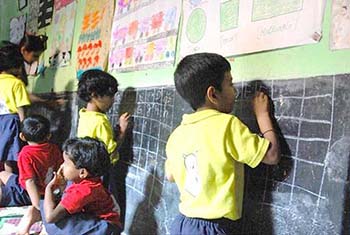
High-frequency word wall
Primary grade texts are comprised primarily of high-frequency words – these are words that occur often in conversation or in books. (Examples are shown in Figure R1.4.) Students learning English can get a boost in their language skills when they recognise these words quickly and easily.
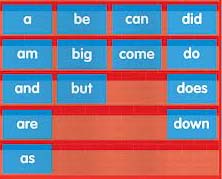
Literature word wall
Word walls can be created to help older students during literature study. The teacher should select key words, new vocabulary words or characters’ names from the piece of literature that the class will be reading. As these words are encountered in the text, they should be written on paper and posted together in a central location in the classroom. The wall will help students to learn these new words and give easy access to important information when discussing the book in class.
A literature word wall can also have pictorial descriptions of the story’s main plot or its characters (Figure R1.5). These pictures can be associated with one line about the story, the characters’ names or anything related to the story that is significant and memorable. A word wall that displays words from a particular story should also include the names of the author, illustrator and translator (if any).
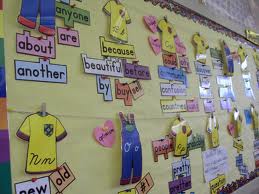
Seasonal word wall
Elementary-grade classrooms study units around the seasons of the year. Thus, ‘seasons’ can be used as a context to develop a word wall (Figure R1.6). Important key words focusing on a particular season can be used to create a seasonal word wall.
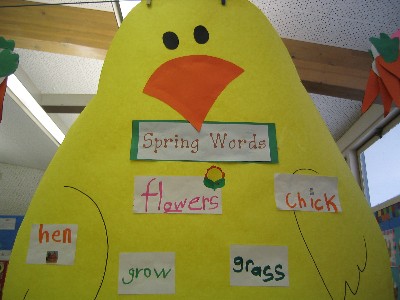
As each word is introduced, it should be written on a piece of paper and posted in the classroom. Over time, a collection of words related to the season will develop. For instance, a wall titled ‘These days (in summer) the markets are full of …’ can display students’ observations regarding seasonal fruits, seasonal vegetables and summer clothing, or other items such as cold drinks, juices, ice creams, umbrellas, sun hats, sunglasses, etc.
At the end of the season the words can be moved to another part of the classroom. As the seasons progress, students will be able to look back at the collections of words associated with each season to see the commonalities and differences between each time of the year.
A word wall may also be used as a resource for other activities. For instance, students could create a new poem or story using words written on an existing word wall. Doing this will give them an opportunity to use the words for different purposes.
Starting the year with young or pre-literate students
Start the school year and the word wall by getting to know your class. Each day, write the names of five students until all the names are on the wall. Spend some time looking at the five names each day, and focus on the sound and letter patterns in the names. For example, if the name ‘Chunni’ is added, you can spend time looking at the ‘ch’ sound and talking about other words that have the same sound.
You can compare new names to the names already on the wall. For instance, is the ‘i’ at the end of Chunni's name different from or similar to the ‘i’ at the end of ‘Kadambari’? In this way, students have their first lessons in letter, sound and spelling patterns.
For any topic, add five words each week to the word wall. You can introduce all five new words on Monday. A useful resource is to place all five words in a pocket chart before the students arrive on Monday morning. The students will want to investigate the new words in the pocket chart as they come into the classroom. Let them handle the words in the pocket chart and try to read them. Sometimes, students will read the new words before ‘word wall time’ in the class. This can lead to interesting discussions and learning.
Writing word wall
Writers, especially those in the younger grades, often have difficulty retrieving a wide variety of vocabulary to use in their writing. You can help spark their memories by posting lists of words on the wall. The list can be general or specific. If your class is studying a particular mode of writing, you can post words that are often used in that type of writing. For example, when the class is working on compare-and-contrast writing, words such as ‘similar’, ‘different’, ‘same’ and ‘opposite’ could be posted on the word wall to remind students to use these in their writing.
Spelling word wall
A spelling word wall should be organised alphabetically to help students locate the words as they need to spell them. The wall should include words that the class encounters and wants to learn to spell. Common spelling errors in writing, key words from literature, weekly spelling lists and even students’ names can be added to the word wall. The wall should always be a ‘work in progress’. Words should be added as you and your class decide they need to learn to spell them. You can cover the spelling word wall with blank paper during spelling tests.
Parts of speech word wall
Sometimes we all struggle to understand which grammatical part of speech a word fits into in an English sentence. To help students understand basic concepts of English grammar, teachers can create a word wall organised by part of speech (i.e. nouns, verbs, adjectives, adverbs). As students learn or study new words, they can add each to the correct grammatical part of speech. If you are teaching students how to add interest to their writing by using adjectives, you can make a word wall of ‘amazing adjectives’. As the class reads stories and poetry, ask the students to listen and look for interesting describing words and add these adjectives to the special word wall. You can have a similar wall for ‘vivid verbs’.
Textbook unit/chapter word wall
The word wall can be an aid for a particular unit or chapter of study. You and your students can select key terms from the unit or chapter, and write them on paper. As each word is introduced, it should be added to the wall alphabetically. At the end of the unit or chapter, the word wall can come down. This is a good way to incorporate a word wall into your classroom if you have limited space. Table R1.1 is an example of this kind of word wall.
Table R1.1 Word wall for ‘The Magic Garden’ (Marigold Class III textbook).
Aa after again against all | Bb birds bread | Cc cans students
| Dd danced dear dig dreaming dress | Ee | Ff fairy flowers | Gg garden gardeners ground | Hh happily help high |
Ii indeed | Jj | Kk | Ll laughing little love | Mm magic morning most | Nn next nothing
| Oo | Pp playground |
quite | Rr roots roses running | Ss school singing students sunflowers sunny sunshine | Tt talking tall thirsty tiny
| Uu | Vv very
| Ww wall watering wings | Xx |
| Yy | Zz |
6 Summary
